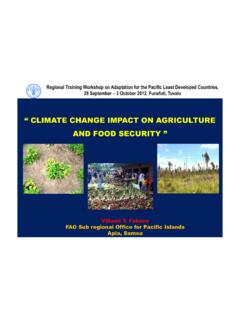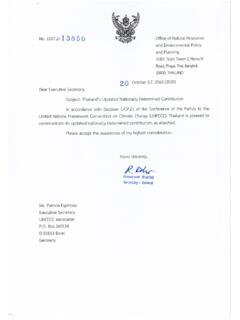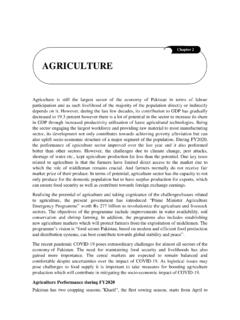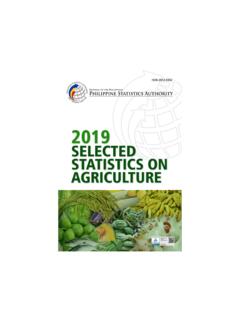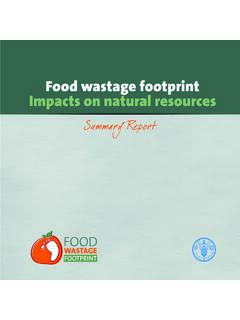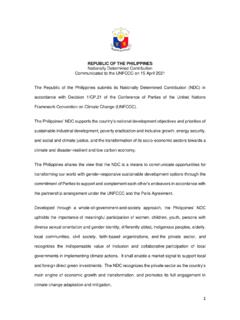Transcription of The contribution of insects to food security, livelihoods ...
1 The contribution of insects To food securiTy, livelihoods and The environmenT1 Why insects ? The use of insects as food and feed has many environmental, health and social/livelihood benefits. For example: environmenTal benefiTs insects have a high feed conversion efficiency because they are cold-blooded. Feed-to-meat conversion rates (how much feed is needed to produce a 1 kg increase in weight) vary widely depending on the class of the animal and the production practices used, but nonetheless insects are extremely efficient.
2 On average, insects can convert 2 kg of feed into 1 kg of insect mass, whereas cattle require 8 kg of feed to produce 1 kg of body weight gain. The production of greenhouse gases by most insects is likely to be lower than that of conventional livestock. For example, pigs produce 10 100 times more greenhouse gases per kg of weight than mealworms. insects can feed on bio-waste, such as food and human waste, compost and animal slurry, and can transform this into high-quality protein that can be used for animal feed. insects use significantly less water than conventional livestock.
3 Mealworms, for example, are more drought-resistant than cattle. Insect farming is less land-dependent than conventional livestock benefiTsThe nutritional content of insects depends on their stage of life (metamorphic stage), habitat and diet. However, it is widely accepted that: insects provide high-quality protein and nutrients comparable with meat and fish. insects are particularly important as a food supplement for undernourished children because most insect species are high in fatty acids (comparable with fish). They are also rich in fibre and micronutrients such as copper, iron, magnesium, manganese, phosphorous, selenium and zinc.
4 insects pose a low risk of transmitting zoonotic diseases (diseases transmitted from animals to humans) such as like H1N1 (bird flu) and BSE (mad cow disease).livelihood and social benefiTs Insect gathering and rearing can offer important livelihood diversification strategies. insects can be directly and easily collected in the wild. Minimal technical or capital expenditure is required for basic harvesting and rearing equipment. insects can be gathered in the wild, cultivated, processed and sold by the poorest members of society, such as women and landless people in urban and rural areas.
5 These activities can directly improve diets and provide cash income through the selling of excess production as street food. Insect harvesting and farming can provide entrepreneurship opportunities in developed, transitional and developing economies. insects can be processed for food and feed relatively easily. Some species can be consumed whole. insects can also be processed into pastes or ground into meal, and their proteins can be This information guide was written by Afton Halloran and Paul Vantomme and is based on Edible insects .
6 Future prospects for food and feed security available at Vantomme Mealworms are sorted prior to freeze drying and packaging, NetherlandsRearing crickets in a plastic bucket using simple tools such as a saucer and cotton for drinkers and folded used carton papers to provide climbing and hiding places for the crickets, KenyaMonica Ayeiko WhaT is enTomophagy? Entomophagy is the consumption of insects by humans. Entomophagy is practised in many countries around the world but predominantly in parts of Asia, Africa and Latin America.
7 insects supplement the diets of approximately 2 billion people and have always been a part of human diets. However, it is only recently that entomophagy has captured the attention of the media, research institutions, chefs and other members of the food industry, legislators and agencies dealing with food and feed. The Edible insects Programme at FAO also examines the potential of arachnids ( spiders and scorpions) for food and feed, although by definition these are not insects conTribuTe To food and feed securiTy?Yes. Population growth, urbanization and the rising middle class have increased the global demand for food, especially animal-based protein sources.
8 The traditional production of animal feed such as fishmeal, soy and grains needs to be further intensified in terms of resource efficiency and extended through the use of alternative sources. By 2030, over 9 billion people will need to be fed, along with the billions of animals raised annually for food and recreational purposes and as pets. Moreover, externalities such as land and water pollution from intensive livestock production and over-grazing are leading to forest degradation, thereby contributing to climate change and other environmentally destructive impacts.
9 Solutions need to be researched and explored. One of the many ways to address food and feed security is through insect farming. insects are everywhere and they reproduce quickly, and they have high growth and feed conversion rates and a low environmental footprint over their entire life cycle. They are nutritious, with high protein, fat and mineral contents. They can be reared on waste streams like food waste. Moreover, they can be eaten whole or ground into a powder or paste, and incorporated into other foods. The use of insects on a large scale as a feed ingredient is technically feasible, and established companies in various parts of the world are already leading the way in this regard.
10 insects as feedstock for aquaculture and poultry feed are likely to become more prevalent within the next gaThering To farming The domestication of insects is a very good idea. To me, it is crucial because it will enable local communities to produce insects so that they will be able to increase supply of insects and, at the same time, increasing production would mean an increase in their income .. Domestication of insects is a win win approach. The insects will be sustainably produced and at the same time the livelihoods of rural communities will continue to improve.










